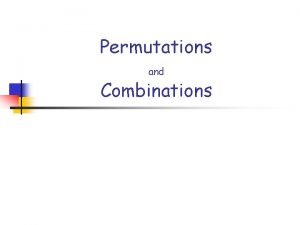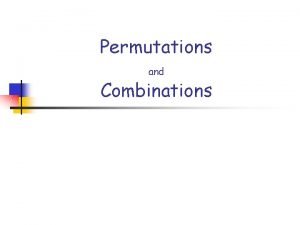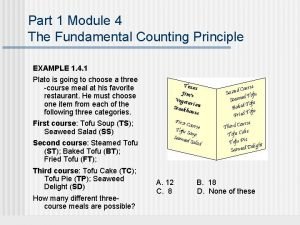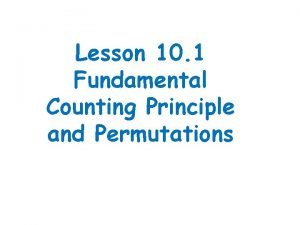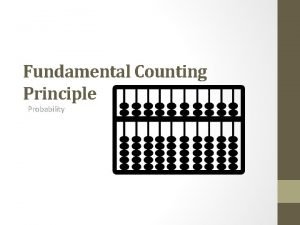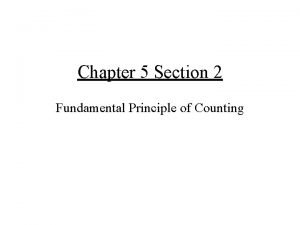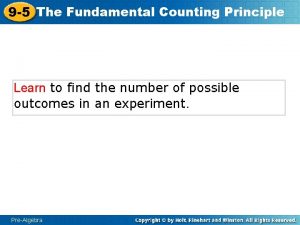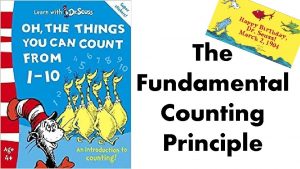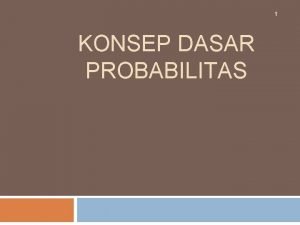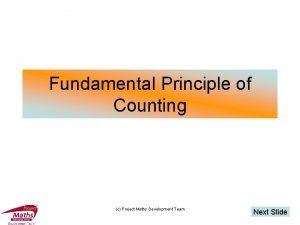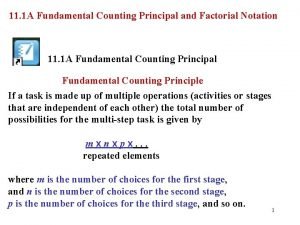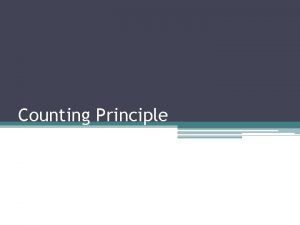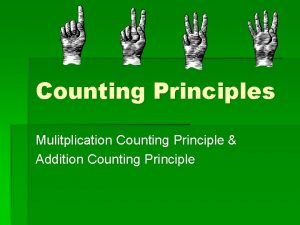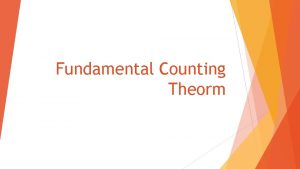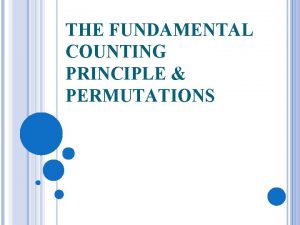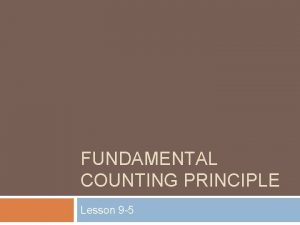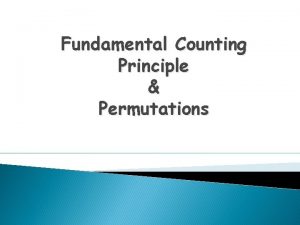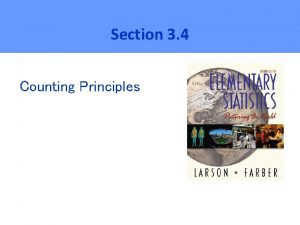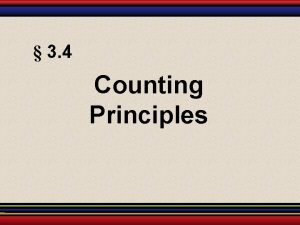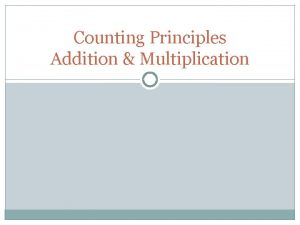3 4 Counting Principles Fundamental Counting Principle If












- Slides: 12

§ 3. 4 Counting Principles

Fundamental Counting Principle If one event can occur in m ways and a second event can occur in n ways, the number of ways the two events can occur in sequence is m· n. This rule can be extended for any number of events occurring in a sequence. Example: A meal consists of a main dish, a side dish, and a dessert. How many different meals can be selected if there are 4 main dishes, 2 side dishes and 5 desserts available? # of main # of side dishes 4 2 There are 40 meals available. # of desserts 5 Larson & Farber, Elementary Statistics: Picturing the World, 3 e = 40 2

Fundamental Counting Principle Example: Two coins are flipped. How many different outcomes are there? List the sample space. Start 1 st Coin Tossed Heads 2 ways to flip the coin Tails 2 nd Coin Tossed Heads Tails 2 ways to flip the coin There are 2 2 = 4 different outcomes: {HH, HT, TH, TT}. Larson & Farber, Elementary Statistics: Picturing the World, 3 e 3

Fundamental Counting Principle Example: The access code to a house's security system consists of 5 digits. Each digit can be 0 through 9. How many different codes are available if a. ) each digit can be repeated? b. ) each digit can only be used once and not repeated? a. ) Because each digit can be repeated, there are 10 choices for each of the 5 digits. 10 · 10 = 100, 000 codes b. ) Because each digit cannot be repeated, there are 10 choices for the first digit, 9 choices left for the second digit, 8 for the third, 7 for the fourth and 6 for the fifth. 10 · 9 · 8 · 7 · 6 = 30, 240 codes Larson & Farber, Elementary Statistics: Picturing the World, 3 e 4

Permutations A permutation is an ordered arrangement of objects. The number of different permutations of n distinct objects is n!. “n factorial” n! = n · (n – 1)· (n – 2)· (n – 3)· …· 3· 2· 1 Example: How many different surveys are required to cover all possible question arrangements if there are 7 questions in a survey? 7! = 7 · 6 · 5 · 4 · 3 · 2 · 1 = 5040 surveys Larson & Farber, Elementary Statistics: Picturing the World, 3 e 5

Checkpoint 1. The starting lineup for a baseball team consists of nine players. How many different batting orders are possible using the starting lineup? 2. The teams in the National League Central Division are: Chicago Cubs, Cincinnati Reds, Houston Astros, Milwaukee Brewers, Pittsburgh Pirates, and St. Louis Cardinals. How many different final standings are possible? Larson & Farber, Elementary Statistics: Picturing the World, 3 e 6

Permutation of n Objects Taken r at a Time The number of permutations of n elements taken r at a time is # in the group # taken from the group Example: You are required to read 5 books from a list of 8. In how different orders can you do so? Larson & Farber, Elementary Statistics: Picturing the World, 3 e many 7

Checkpoint 1. Find the number of ways of forming 3 -digit codes in which no digit is repeated. 2. In a race with 8 horses, how many ways can 3 horses finish in 1 st, 2 nd, or 3 rd place? (Assume no ties) 3. Forty-three race cars started the 2004 Daytona 500. How many ways can the cars finish 1 st, 2 nd, and 3 rd? (Assume no ties) Larson & Farber, Elementary Statistics: Picturing the World, 3 e 8

Distinguishable Permutations The number of distinguishable permutations of n objects, n 1 are one type, n 2 are another type, and so on is where Example: Jessie wants to plant 10 plants along the sidewalk in her front yard. She has 3 rose bushes, 4 daffodils, and 3 lilies. In how many distinguishable ways can the plants be arranged? Larson & Farber, Elementary Statistics: Picturing the World, 3 e 9

Checkpoint 1. A building contractor is planning to develop a subdivision. The subdivision is to consist of 6 one-story houses, 4 two-story houses, and 2 split-level houses. In how many distinguishable ways can the houses be arranged? 2. A contractor wants to plant six oak trees, nine maple trees, and five poplar trees along the subdivision street. The trees are to be spaced evenly apart. In how many distinguishable was can they be planted? Larson & Farber, Elementary Statistics: Picturing the World, 3 e 10

Combination of n Objects Taken r at a Time A combination is a selection of r objects from a group of n things when order does not matter. The number of combinations of r objects selected from a group of n objects is # in the collection # taken from the collection Example: You are required to read 5 books from a list of 8. In how many different ways can you do so if the order doesn’t matter? Larson & Farber, Elementary Statistics: Picturing the World, 3 e 11

Application of Counting Principles Example: In a state lottery, you must correctly select 6 numbers (in any order) out of 44 to win the grand prize. a. ) How many ways can 6 numbers be chosen from the 44 numbers? b. ) If you purchase one lottery ticket, what is the probability of winning the top prize? a. ) b. ) There is only one winning ticket, therefore, Larson & Farber, Elementary Statistics: Picturing the World, 3 e 12
 Permutations and combinations
Permutations and combinations Counting principle formula
Counting principle formula Fundamental counting principle example
Fundamental counting principle example Permutations
Permutations Counting principle tree diagram
Counting principle tree diagram Fundamental counting principle definition
Fundamental counting principle definition Tree diagram outcomes
Tree diagram outcomes Fundamental counting principle
Fundamental counting principle The principles of probability
The principles of probability What is the fundamental principle of counting
What is the fundamental principle of counting Table
Table Fundamental counting principle and factorial notation
Fundamental counting principle and factorial notation Fundamental counting pronciple
Fundamental counting pronciple
